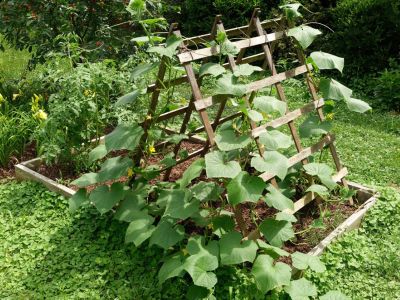Trellis Support for Plants
Trellising in gardens does, indeed, allow and encourage the upward growth of bountiful blooms or attractive foliage. A trellis is often attached to a pergola. Using them together provides upward growth on the sides and spreading growth on top. That said, they’re most often freestanding. A trellis is used for more than ornamental greenery and blooms though. It can be a great support for many fruits and vegetables that grow in your edible garden. Upward growth allows you to conserve space and grow more in a small area. Harvesting is easier, with less bending and stooping. Any plant that spreads from runners can be trained upward. Special provisions may be necessary to hold growing fruit as it gets large, but the issue is not with the plant growing upward. Any crop trained to grow upward has the benefit of staying off the ground and has less potential for rotting or other damage that happens when edibles lay on the ground. Various trellis types are usually attractively put together, but any upward support works for crops like peas and indeterminate tomatoes. When starting a crop on a trellis, it may need training, but many species readily grab onto any support that is close enough for vines to reach. You can put together a simple trellis for use in the vegetable garden. Those that support ornamentals may need a little more planning to increase your curb appeal. No garden? That’s okay. There are many options for houseplant trellises too.
How to Make a Trellis
Latticework is associated with the trellis and is often used along with one by one poles or planks. Sometimes, wire is used instead. Have some idea how much weight your trellis needs to hold when choosing materials. Designs for building a trellis are plentiful online. Many are pyramidal poles in the ground with mesh or chicken wire between. Before buying a trellis, check for materials you may already have available.
